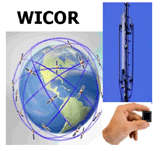
-
StatusCompleted
-
Status date2014-12-09
The key-objective of WICOR was to design and develop a multifunctional 'black-box' that consists of an intelligent user terminal router and provide interfaces to multiple communication systems. SatCom, GSM/GPRS, and WLAN were considered. The 'black box' also incorporates a positioning capability (GPS). The core element of this 'black-box' is a processor with dedicated software to manage the overall system.
The main task of this software is to analyse permanently the 'communication environment' to identify whether GSM/GPRS is available and, if not, switch to SatCom.
WICOR defined, developed and demonstrated prototype services for safety & security related users. The overall design of the 'black-box' was defined and developed in such a way, that it resulted in a maximum level of flexibility for customers to select systems of their choice (e.g. INMARSAT or Globalstar as SatCom systems, GSM or Tetra(pol) as cellular networks and WLAN or bluetooth as local area systems).
Even the selection of multiple systems of each category is supported. The selection of the communication system to be used is managed by appropriate software and takes into account predefined and user specific preferences (e.g. communication cost, data security, reliability of connection over a predefined period of time, etc.).
- Technical Analysis:
Including: availability, formats, transfer rates, time delay, integrity, internal status information, size, weight, power consumption, costs, etc. - System & Service Definition:
Definition of messages, data, and voice connection, based on a detailed analysis of user requirements (mapped with the technical solutions). - System & Service Development:
Define hard- and software development requirements, and production of prototype system. - Feasibility Demonstration:
Demonstrations in Germany, Austria, and Switzerland were carried out to investigate the system behaviour under realistic conditions. - Financial Analysis:
A financial analysis was carried out to identify the major elements of a business case for the further development towards a product and the related services.
WICOR improves the communication capability for various safety & security related applications, which suffer from limited availability of a single communication source. E.g. satellite communication requires a direct line-of-sight (LoS) to the satellite, cellular networks have restricted coverage in rural/remote areas, WLAN is restricted to access points, etc.
Those users in need of permanent access to communication links have to be equipped with a number of communication devices to assure that one of them is ready to use in case a communication link is required. By combining a variety of communication links in an intelligent way, it is the intention of WICOR to choose the most cost-effective, secure data transfer channel possible thus creating new applications and prospects.
| The main elements of the WICOR system are the mobile terminal and an application server. Both elements are connected via multiple communication-links, and each of the two elements provides application specific functionalities and HMIs. The WICOR-architecture is illustrated in the figure to the right: |
|
The required modules for the different system levels define the necessary computing power, memory structure etc. While still taking into account that for the communication media there is standard user equipment currently available on the market, it was possible to quickly construct a prototype based on procured COTS equipment (standard PC hardware and external components). This enabled early testing of the system.
The software development was carried out in a standard environment, which provides the basis for a future target system. A clear modular structure supports easy changing of communication media, application levels and functionalities. The development language was ANSI-C. The software structure was partitioned into machine dependent and independent modules.
The key-milestones of the WICOR-project were:
- Kick-Off Meeting (KOM), February 2003
Start of WICOR-activities.
- Requirements Review (RR), April 2003
Review of available technology, potential user groups, potential applications, and future markets. First concept of the WICOR system and WICOR services.
- Baseline Design Review (BDR), July 2003
Review of the WICOR system definition with focus on the mobile terminal (communication router) and definition of the terminal acceptance plan. Definition of four WICOR services, i.e. patrol, tracking, SAR, large scale operation and definition of the demonstration plan.
- Critical Design Review (CDR), August 2003
Review of the detailed WICOR system and services
- Preliminary System Validation (PSV), November 2003
Validation of the WICOR system within the development phase
- Mid Term Review (MTR), January 2004
Review of the WICOR system after the development phase, and start of the demonstration phase
- Final Review (FR), April 2004
Final Review of the demonstration phase and the overall project
The project was closed-out in April 2004. The findings and results of the WICOR project have provided input to the SARFOS project.



